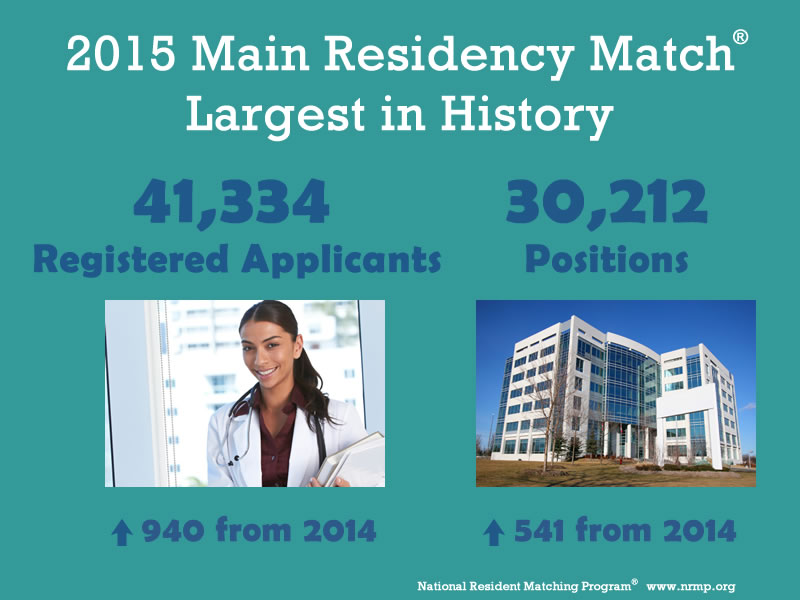Earlier this month, hopeful and anxious medical school students gathered at Match Day ceremonies across the country. Match Day, an annual rite of passage for budding physicians, is the day students learn which U.S. residency programs at which they will train for the next three to seven years.
This year was record setting in several respects and, as usual, Collegiate Gateway is here to bring you the most important trends and developments.
More people, more positions
The National Resident Matching Program (NRMP) recently announced that 2015 is the largest Main Residency Match in NRMP history. This year included 41,334 total registrants, the largest number on record. This growth in the number of U.S. seniors is attributable to rising medical school enrollments and the development of new medical schools across the country. In keeping, more than 30,000 total positions were offered in 2015, another record high.
Good News for US Graduates
Of this year’s 18,025 U.S. allopathic seniors participating in the match, 16,932 were matched to first-year positions, achieving an overall match rate of 93.9 percent. Of those, 51.6 percent matched to their first choice for training. In addition, 2,949 osteopathic students and graduates submitted program preferences, an increase of more than 200. Their match rate rose to 79.3 percent – another record high.
Osteopathic medicine is very similar to the traditional allopathic approach, but with a greater emphasis on hands-on physical diagnosis techniques, as well as a more personal, holistic approach. In the past, there had been distinct accreditations for allopathic (MD) and osteopathic (DO) residency programs. However, in February 2014, the accrediting agencies decided on a single system for residencies and fellowships to begin in 2015 and be fully implemented by 2020. Keep an eye out for our upcoming blog that will delve deeper into the similarities and differences between MD and DO training.
According to a recent report in Slate, the outlook is also good for those who have not, unfortunately, been matched:
“Although failure to match is chastening, U.S. graduates have an excellent chance at finding a program the next year. In the meantime, many of them get a master’s degree, or they teach or work in a laboratory to strengthen their applications. If they decide not to pursue a residency, it’s almost always by choice. Despite the pressure of Match Day, life is pretty forgiving to U.S. medical school graduates.”
Another option for unmatched applicants is the Supplemental Offer and Acceptance Program (SOAP), during which unfilled positions are made available to unmatched applicants. In fact, there were 1,193 unfilled positions offered during the 2015 SOAP.
For Internationals, Challenges Remain
In keeping with previous years, however, graduates of foreign medical schools have a more difficult time matching. This year, 12,380 doctors attempted to match from medical schools outside the United States. Only 6,301 were successful, yielding an approximately 50 percent acceptance rate. Though low compared to the numbers for U.S. medical school graduates, 50 percent is actually a somewhat inflated statistic; these students often apply for programs such as family medicine that generally have difficulty filling their many available positions.
Couples matching
The NRMP allows those with spouses, partners, and significant others, to participate in the Match as a couple: any two candidates can link their preference lists together in the hopes of being paired to the same or nearby programs. An all-time high of 1,035 couples participated in the Match – 110 more than last year – with a 94.8 percent match rate.
Trends in Specialties
Over the next decade, the AAMC predicts that the US will face a shortage of as many as 90,000 doctors. As such, efforts to expand residency positions are common, with particularly high growth in several key areas. Notably, nearly 60% of all new positions were attributable to primary care, an area particularly in need of new doctors.
Specialty Total positions New positions % Filled
| Internal Medicine | 6,770 | 246 | 98.9 |
| Family Medicine | 3,195 | 86 | 95.1 |
| Pediatrics | 2,668 | 28 | 99.5 |
Some of the most competitive specialty areas included the following, which filled 100% of available first-year positions:
- Dermatology
- Medicine-Psychiatry
- Obstetrics and Gynecology
- Orthopedic Surgery
- Pediatrics-Primary Care
- Physical Medicine/Rehabilitation
- Thoracic Surgery
Additionally, General Surgery, Neurological Surgery, Otolaryngology, Plastic Surgery, and Radiation Oncology had fewer than 5 unfilled positions remaining after the matching algorithm was processed. Watch for our upcoming blog on the differences between various specialty residency programs.
The road to becoming a doctor is a long and complex one. For more information on the residency match process, or any other part of the process, contact Collegiate Gateway – as always, we’re happy to help.


